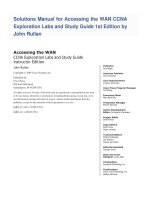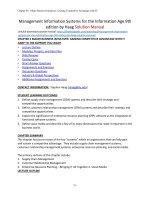Solutions manual for theatre the lively art 9th edition by edwin wilson and alvin goldfarb
Bạn đang xem bản rút gọn của tài liệu. Xem và tải ngay bản đầy đủ của tài liệu tại đây (217 KB, 3 trang )
Solutions Manual for Theatre The Lively Art 9th Edition by
Edwin Wilson and Alvin Goldfarb President
Link full download Test Bank:
/>Link full download Solutions Manual:
/>
1
Theatre is Everywhere
Overview and Outline
Why should I study theatre?
Before the rise of technology the only way audiences could see theatre was to leave their
homes and attend a live performance. In the face of such technology spectators still
attend the theatre primarily because it is live.
The most significant difference between films and theatre is the relationship between the
performer and the audience. At the heart of the theatre experience, therefore, is the
performer–audience relationship—the immediate, personal exchange whose chemistry
and magic give theatre its special quality.
One measure of the amazing health of live theatre today is the astounding range of
opportunities we have of attending theatre, with locations, not only in the United States
but throughout the world, presenting a greater variety of theatre offerings
perhaps than ever before.
A rising consciousness of diversity has been reflected in live performance in the form of
global and multicultural theatre. Many organizations have emerged that present
productions by and for groups with specific interests including feminism; gay, lesbian, bisexual and transgendered points of view; and many others relating to diversity in politics,
race, gender, ethnic background, and sexual orientation. We also see this diversity in the
form of global theatre.
Theatre is the fountainhead of all drama in whatever form it appears: film, television,
computer, or theme park.
The characters of film and television—the heroes, the villains, the victims, the comic
figures—all come straight from predecessors in theatre. The way stories are
structured—the early scenes, the succession of crises, the withholding and revealing
Copyright © 2016 McGraw-Hill Education. All rights reserved. No reproduction or distribution without the
prior written consent of McGraw-Hill Education.
Solutions Manual for Theatre The Lively Art 9th Edition by
Edwin Wilson and Alvin Goldfarb President
of information—were there first, hundreds of years ago, in the theatre.
Our interest in media stars’ performances and lives parallels the way audiences
throughout the history of theatre have engaged with actors and actresses.
We can see the impact of theatre all around us today. Theatre exists in many aspects of
our everyday lives and has influenced many of our popular entertainments.
Theatre permeates our everyday lives as we and those with whom we interact play roles.
We play such roles at work, at home, and with those we know and love.
Rock and roll performances emphasize stage spectacle, lighting, and sound effects.
We can also see theatrical influences in our visits to amusement parks and museums.
When we visit dinner theatres throughout the country, and when we visit Las Vegas, we
recognize the pervasiveness of theatrical elements.
Digital media from the computer to Xbox to the iPad and smartphones are clearly
influenced by theatre.
While theatre may amuse it also has the unique ability to incorporate in dramatic material
profound, provocative, timeless observations about our human condition.
I.
II.
Theatre Today
A. The Unique Quality of Theatre
B. The Range and Accessibility of Theatre
C. Global and Multicultural Theatre
Theatre, Television, and Film
A. Theatre and Television
B. Theatre and Film
III.
Theatre is Everywhere
A. Theatre and Rock Music
B. Theatricality in Amusement Parks, Museums, Las Vegas and Sporting Events
C. Theatre and Digital Media
IV.
Theatre and the Human Condition
Feature:
Playing Your Part: Thinking About Theatre
Terms
Copyright © 2016 McGraw-Hill Education. All rights reserved. No reproduction or distribution without the
prior written consent of McGraw-Hill Education.
Solutions Manual for Theatre The Lively Art 9th Edition by
Edwin Wilson and Alvin Goldfarb President
nonmediated theatre
regional theatres
community theatres
site specific theatre
performance art
global theatre
Topics for Discussion
1. Has the mass media, such as TV and film, replaced the need for theatre? If all these
ways of telling stories already exist, why do we need theatre at all?
2. This chapter says we all play roles in our lives. Does this mean that there is no “real
us”? Are we all always actors?
3. Why do you think that our world is becoming more and more theatrical? Why would
this be a trend right now? Is it something to be resisted or embraced?
4. Why are we fascinated with celebrities? What effect do you think this adulation has
on the personal and artistic lives of these celebrities?
5. The textbook discusses theatrical elements that appear in rock concerts and places
such as Las Vegas and Disneyland. What other examples can you provide of
theatrical elements appearing in concerts, sporting events, or other arenas? What
purpose do theatrical elements serve in these instances?
Exercises and Demonstrations
1. Visit websites for the major hotels in Las Vegas. What theatrical aspects are they
emphasizing? Make notes for examination when you have finished reading later
chapters of this textbook. How are lighting, costumes, sound, sets, and story being
used to draw people to the casinos?
2. Watch one of the filmed productions of the Cirque du Soleil. How has the traditional
circus been transformed using theatrical elements?
3. If you happen to be producing a play that is also available in a film version, select
specific scenes for the class to focus on in performance and then compare reactions
and responses about those scenes in the live performance versus the film version.
Copyright © 2016 McGraw-Hill Education. All rights reserved. No reproduction or distribution without the
prior written consent of McGraw-Hill Education.









